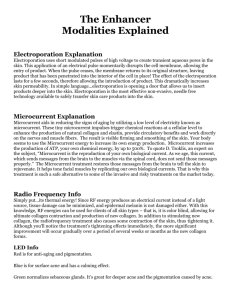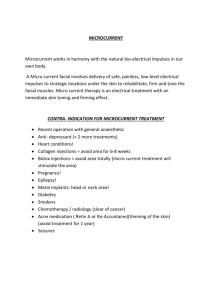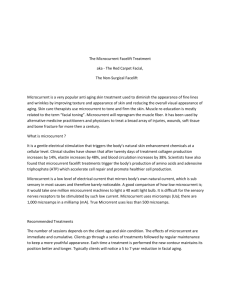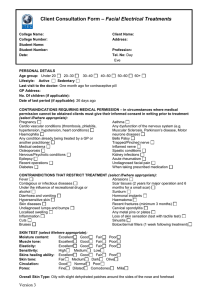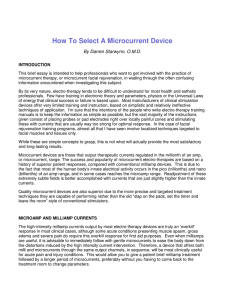Microcurrent Device Comparison - Best
advertisement
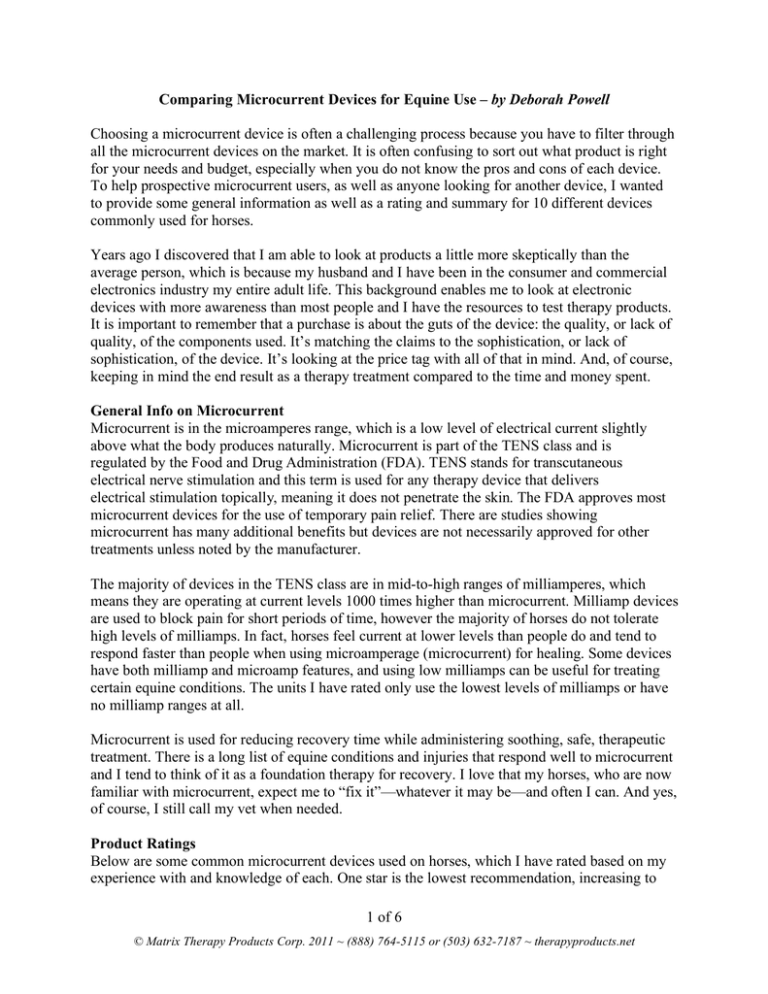
Comparing Microcurrent Devices for Equine Use – by Deborah Powell Choosing a microcurrent device is often a challenging process because you have to filter through all the microcurrent devices on the market. It is often confusing to sort out what product is right for your needs and budget, especially when you do not know the pros and cons of each device. To help prospective microcurrent users, as well as anyone looking for another device, I wanted to provide some general information as well as a rating and summary for 10 different devices commonly used for horses. Years ago I discovered that I am able to look at products a little more skeptically than the average person, which is because my husband and I have been in the consumer and commercial electronics industry my entire adult life. This background enables me to look at electronic devices with more awareness than most people and I have the resources to test therapy products. It is important to remember that a purchase is about the guts of the device: the quality, or lack of quality, of the components used. It’s matching the claims to the sophistication, or lack of sophistication, of the device. It’s looking at the price tag with all of that in mind. And, of course, keeping in mind the end result as a therapy treatment compared to the time and money spent. General Info on Microcurrent Microcurrent is in the microamperes range, which is a low level of electrical current slightly above what the body produces naturally. Microcurrent is part of the TENS class and is regulated by the Food and Drug Administration (FDA). TENS stands for transcutaneous electrical nerve stimulation and this term is used for any therapy device that delivers electrical stimulation topically, meaning it does not penetrate the skin. The FDA approves most microcurrent devices for the use of temporary pain relief. There are studies showing microcurrent has many additional benefits but devices are not necessarily approved for other treatments unless noted by the manufacturer. The majority of devices in the TENS class are in mid-to-high ranges of milliamperes, which means they are operating at current levels 1000 times higher than microcurrent. Milliamp devices are used to block pain for short periods of time, however the majority of horses do not tolerate high levels of milliamps. In fact, horses feel current at lower levels than people do and tend to respond faster than people when using microamperage (microcurrent) for healing. Some devices have both milliamp and microamp features, and using low milliamps can be useful for treating certain equine conditions. The units I have rated only use the lowest levels of milliamps or have no milliamp ranges at all. Microcurrent is used for reducing recovery time while administering soothing, safe, therapeutic treatment. There is a long list of equine conditions and injuries that respond well to microcurrent and I tend to think of it as a foundation therapy for recovery. I love that my horses, who are now familiar with microcurrent, expect me to “fix it”—whatever it may be—and often I can. And yes, of course, I still call my vet when needed. Product Ratings Below are some common microcurrent devices used on horses, which I have rated based on my experience with and knowledge of each. One star is the lowest recommendation, increasing to 1 of 6 © Matrix Therapy Products Corp. 2011 ~ (888) 764-5115 or (503) 632-7187 ~ therapyproducts.net five stars for the devices I found to have the best qualities for their cost. I also included brief descriptions on how I determined my personal ratings. The costs are approximate for each basic equine package because prices are subject to change and there are variations in accessory packages available. Classification If a device has approval by the Food and Drug Administration (FDA) that means it can be used as a medical device for the claims the manufacturer has cleared it for, which vary per device. CE classification means that the manufacturer has declared that the product meets the European Commission’s safety, health, and environment requirements. When a product has ISO certification that means it meets the International Organization for Standardization’s (ISO) worldwide standard requirements in quality control in the manufacturing process. Electro-Acuscope/Myopulse - ★ • $15,000 to $20,000 for full system (two devices & accessories) • Large, semi-portable devices; weigh approximately 25 lbs each (plus case) • Large lead-acid batteries • Made in the USA • FDA, CE The Electro-Acuscope and Myopulse are two separate devices and both are electronically outdated machines with only around twelve frequencies. The Acuscope comes with remote-start probes for treating and reading acupoints and has GSR (galvanic skin resistance reading), which is a nice feature. The Myopulse, which has no GSR, must be purchased to have polarity control and a modified waveform. The brass plates (electrodes) used are heavy and non-conforming to the body, and even though they never wear out they require more conductive gel and longer preparation than other options. Another con is the requirement to return the unit to the manufacturer for battery replacement, which costs approximately $800. However, I do know people who have found slightly cheaper sources for their batteries. The certification and training is another problem, some people mistaken it as a legal license to treat paying clients’ horses. Only vets can legally treat horses with the Acuscope and Myopulse, unless the user is under a vet’s supervision. Some models state that they are “calibrated for equines,” but this appears to be more of a marketing tool than anything practical because the majority of these machines are the original devices for people. For the cost-to-features ratio, this is not a recommended microcurrent device to purchase. EquiStim Leg Saver - ★ • $3,390 for equine package • Small, portable device • Rechargeable battery • Classification: None Found Although similar in function to the Micro 400, the EquiStim Leg Saver lacks the Micro 400’s user controls and features. The EquiStim Leg Saver offers alternating current and an intensity setting but has no other user controls. The package includes nice accessories, and it appears the 2 of 6 © Matrix Therapy Products Corp. 2011 ~ (888) 764-5115 or (503) 632-7187 ~ therapyproducts.net accessories are what increase the purchase price. The EquiStim Leg Saver seems to have no FDA, ISO, CE, or other ratings and is only marketed for animal use. This product has a low costto-features/quality ratio and is not a recommended choice for its high price. One pro is that the EquiStim Leg Saver has a rechargeable battery. AlphaStim 100 - ★★ • $995 for basic package • Small portable device • 9-volt battery • Made in Japan • FDA, CE This is a high-quality unit, but has minimal features. The package includes plastic acupoint probes and most users report disappointment in the plastic probes for use on animals. A downside is that the device only offers alternating current and has a limited choice of frequencies. The AlphaStim 100 is a high-priced option for a small, portable unit. MicroStim II - ★★ • $170 for basic equine package • Small portable device • 9-volt battery • Made in Japan • FDA, CE There are many models in this category. A couple cons are that users are unable to choose an exact level of microamps and these devices are limited to three frequencies and alternating current. When at the higher levels on the controls, treatment reaches one to two milliamps, which is often uncomfortable for horses. The MicroStim II works well and is cheap enough that after outfitting it with equine accessories it is able to do an adequate job. There are variations in price based on how many equine accessories are added to the basic package. StimPlus - ★★ • $150 for unit • Very small portable device • 2 small lithium batteries (same as used in watches) • Made in China • CE (not sold as a medical device) The StimPlus comes equipped with a fine-point end only for acupoints. The StimPlus has the acupoint locator feature (using GSR), three frequencies, and selectable intensity in microamps. Most acupoint finders in this category use milliamps, which is not as ideal as microamps. This petite, handheld unit is a good alternative to other acupoint finders on the market because it also has the ability to deliver therapeutic microcurrent. Many horses like the tiny point stimulation this device delivers. This is a good low-budget alternative to point finder boxes with combs, which cost several thousand dollars in the horse market. 3 of 6 © Matrix Therapy Products Corp. 2011 ~ (888) 764-5115 or (503) 632-7187 ~ therapyproducts.net Micro 400 - ★★★ • $200 for basic equine package • Small portable device • 9-volt battery (short battery life) • Made in Taiwan • FDA, CE The Micro 400 has four frequencies, alternating current, and is adjustable to low milliamps using higher voltage. The inclusion of carrier background frequencies makes the Micro 400 an excellent low-cost unit for colic and acute conditions. It also does a good job on other conditions. In some cases it is beneficial for a horse to receive long exposure to microcurrent, so unattended treatments are necessary. This unit is ideal for this scenario because if it is damaged when left on a horse it is not a huge financial loss. Matrix MCT Patch - ★★★ • $25 - $40 (lowest cost option) • Disposable patches, no replacement batteries • Made in China • FDA, CE This is a disposable unit and is the cheapest microcurrent option on the market. It is composed of two patches connected with a 9-inch wire. The unit runs an average of 200 to 500 hours before being discarded when the battery has been exhausted. The MCT Patch turns on when applied and automatically turns off when not in use. It can be used continuously for several days or for shorter periods and saved for another treatment. When used correctly, the battery lasts longer as the injury heals. This is because when the MCT Patch is working hard the life of the patch is shorter. The MCT Patch operates at an average of 45 microamps with no frequency and declines in output as the battery power is diminished. The MCT Patch is great for legs and foot issues, such as stone bruises and abscesses, because it can be applied to difficult locations. A couple minor drawbacks are that the pads get grungy and the indicator light sometimes stays on after removal (but does not significantly drain battery power). Also, the patches have several year shelf lives but need to be stored at room temperature. The best treatment results are seen when the MCT Patch is used in conjunction with other microcurrent treatments. The Matrix MCT Patch is a good value purchase for low-cost, unattended treatments. Precision MicroStim - ★★★½ • $4,500 for basic equine package • Large, portable device; weighs 16 lbs • 8 D-cell batteries • Made in the USA • FDA, CE The Precision is the re-engineered label from Dr. Wing’s MENS units. Dr. Wing was the inventor of microcurrent devices in the United States and his initial models were called Automatic and Myomactic. The Precision’s features include using internal solid-state modules, GSR, 1000 selectable frequencies, polarity control, adjustable waveform control, and dual 4 of 6 © Matrix Therapy Products Corp. 2011 ~ (888) 764-5115 or (503) 632-7187 ~ therapyproducts.net channels. It comes standard with remote-start acupoint probes and eight D-cell batteries. The Precision is fairly large, weighing 16 pounds, and looks like an old-style electronics test meter. If looking for the functions listed, it is a suitable choice. When compared to the Acuscope and Myopulse units, the Precision provides all of the features of the Acuscope and Myopulse in just one unit. Also, it has adjustable wave slopes, batteries you can change yourself, weighs 50 pounds less, and has 1000 frequencies rather than only 12. The Precision is a good microcurrent method, especially for all-body treatments and gathering GSR readings over large distances across your horse’s body. With just a couple days of training, using the Precision is easily mastered. Although the Precision is outdated in design and features for the price, it is still a reliable, reasonably portable option. It is also long lasting and is the only product on the market with these features for this low of a price. MicroPlus - ★★★★ • $270 for basic equine package • Small handheld device • 9-volt batter • Made in the USA • FDA, CE, ISO This is a low-cost handheld unit that has five frequencies, can adjust between positive, negative or alternating current, and is able to switch from microamps to milliamps. The MicroPlus has polarity control as well as stable and accurate current selections, which is unique for a device in this price range. The MicroPlus has very soft voltage outputs, which makes it one of my favorites in the low-cost category. Quality is very good and it has FDA, CE, and ISO certification. One con is that you must know the little tricks to get the best results and effectively use the full features of this unit. The MicroPlus has a 5-year warranty and overall is a good choice for the price. Best-Vet - ★★★★ • $970 for basic equine package • Small handheld device • 2 AA batteries (long battery life) • Made in the USA • FDA, CE, ISO The electrode comb and other accessories, like the acupoint pen, do not require return electrodes, which simplifies the treatment and eliminates prep time. The Best-Vet can also be used in the standard positive/negative setup. The device is digital and very electronically sophisticated. Registered as a biofeedback microcurrent device, the Best-Vet has simple choices of programs and amplitude (current) controls. All programs have automatic biofeedback that causes the device to adjust signals based on information received from the body. One program allows the user to see light indicators and audio tones when areas in need of correction are found, then it automatically delivers a corrective signal - all in one easy step. The rest of the programs perform the same biofeedback function automatically but do not display lights and sounds. Another pro is that the Best-Vet has FDA, CE, and ISO certification. A couple 5 of 6 © Matrix Therapy Products Corp. 2011 ~ (888) 764-5115 or (503) 632-7187 ~ therapyproducts.net minor cons are that the indicator lights could be brighter (for the barn) and audio tones are too soft for some people to hear, also a second channel would be nice. The Best–Vet is easy to use, but a small amount of training is required for the best results. All in all, the Best-Vet delivers a lot of bang for your buck. When shopping for therapy devices it is easy to get caught up in the emotion of trying to help our horses. However, when choosing an electronic therapy product it is important to use the same scrutiny as you would when shopping for other electronic devices (such as computers and phones). This way you can find a device that meets your needs and fits your budget. Deborah Powell is the author of MicroCurrent Therapy for Horses and other vital therapies you should know. Additional information can be found at the Matrix Therapy Products website, therapyproducts.net 6 of 6 © Matrix Therapy Products Corp. 2011 ~ (888) 764-5115 or (503) 632-7187 ~ therapyproducts.net
